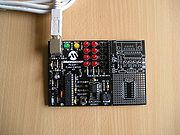
PICKit
Encyclopedia


Programmer (hardware)
In field of computer hardware, the term programmer, chip programmer or device programmer refers to a hardware device that configures programmable non-volatile circuits such as EPROMs, EEPROMs, Flashs, PALs, FPGAs or programmable logic circuits....
for PIC microcontroller
PIC microcontroller
PIC is a family of Harvard architecture microcontrollers made by Microchip Technology, derived from the PIC1650 originally developed by General Instrument's Microelectronics Division...
s made by Microchip Technology
Microchip Technology
Microchip Technology is an American manufacturer of microcontroller, memory and analog semiconductors. Its products include microcontrollers , Serial EEPROM devices, Serial SRAM devices, KEELOQ devices, radio frequency devices, thermal, power and battery management analog devices, as well as...
. They are used to program and debug microcontrollers, as well as program EEPROM. Some models also features logic analyzer and serial communications (UART) tool.
The people who develop open-source software for the PICkit use a mailing list for collaboration.
PICkit 1
The PICkit 1 — introduced on March 31, 2003 for US $36 — was a rudimentary USBUniversal Serial Bus
USB is an industry standard developed in the mid-1990s that defines the cables, connectors and protocols used in a bus for connection, communication and power supply between computers and electronic devices....
programmer for PIC microcontrollers, produced by Microchip Technology
Microchip Technology
Microchip Technology is an American manufacturer of microcontroller, memory and analog semiconductors. Its products include microcontrollers , Serial EEPROM devices, Serial SRAM devices, KEELOQ devices, radio frequency devices, thermal, power and battery management analog devices, as well as...
, the manufacturers of the PIC series of microcontrollers. It was integrated into a demo board featuring 8 LED
LEd
LEd is a TeX/LaTeX editing software working under Microsoft Windows. It is a freeware product....
s, a switch, and a potentiometer
Potentiometer
A potentiometer , informally, a pot, is a three-terminal resistor with a sliding contact that forms an adjustable voltage divider. If only two terminals are used , it acts as a variable resistor or rheostat. Potentiometers are commonly used to control electrical devices such as volume controls on...
. Its default program (explained in the documentation) rotates the LEDs in series. The light display's direction and speed of rotation can be changed with the button and potentiometer on the PICkit board.
PICkit 2
The PICkit 2 — introduced in May 2005 — replaced the PICkit 1. The most notable difference between the two is that the PICkit 2 has a separate programmer/debugger unit which plugs into the board carrying the chip to be programmed, whereas the PICkit 1 was a single unit. This makes it possible to use the programmer with a custom circuit board via an In Circuit Serial Programming (ICSP) header. This feature is not intended for so-called "production" programming, however.The PICkit 2 uses an internal PIC18F2550 with FullSpeed USB. The latest PICkit 2 firmware allows the user to program and debug most of the 8 and 16 bit PICmicro and dsPIC members of the Microchip product line.
The PICkit 2 is open to the public, including its hardware schematic, firmware source code (in C language) and application programs (in C# language). End users and third parties can easily modify both the hardware and software for enhanced features. e.g. GNU/Linux version of PICKit 2 application software, DOS style CMD support, etc.
The PICkit 2 has a programmer-to-go (PTG) feature, which can download the hex file and programming instructions into on-board memory (128K byte I2C EEPROM or 256K byte I2C EEPROM), so that no PC is required at the end application.
The Microchip version of PICkit 2 has a standard 128K byte memory. 256K byte memory can be achieved by modifying the hardware or from third party.
Additionally, a 500 kHz three-channel logic analyser and a UART tool are built into the PICKit 2. These features are missing from the PICkit 3.
Since release of V2.61, PICkit 2 PC software now support maximum 4M bytes of memory for programmer-to-go feature. This modification makes the PICKit 2 support 8x more memory than the PICKit 3. This enhancement has been contributed by Au Group Electronics and the PICkit 2 firmware is also reported to be submitted to Microchip PICkit 2 team in the middle of March 2009. Hopefully this enhancement will be integrated into future firmware releases too.
PICkit 3
Microchip has gone on to manufacture the PICkit 3, an improved version of the PICkit 2 with the same form factor and a new translucent case. It features a faster 16-bit PIC24F processor and a wider voltage regulation range.Both PICkit 2 and PICkit 3 have internal, switch-mode voltage regulators. This allows them, in the case of the PICkit 2, to generate voltages from 2.5 to 5 volts, or in the case of the PICkit 3, 2.5 to 5.5 volts, from 5V USB, at around 100mA. Both have options for calibrating the output with a multimeter, for increased accuracy. Additionally, for some PICs, the MCLR programming voltage can be generated, at around 13-14 volts. This voltage is required to reprogram the flash memory.

